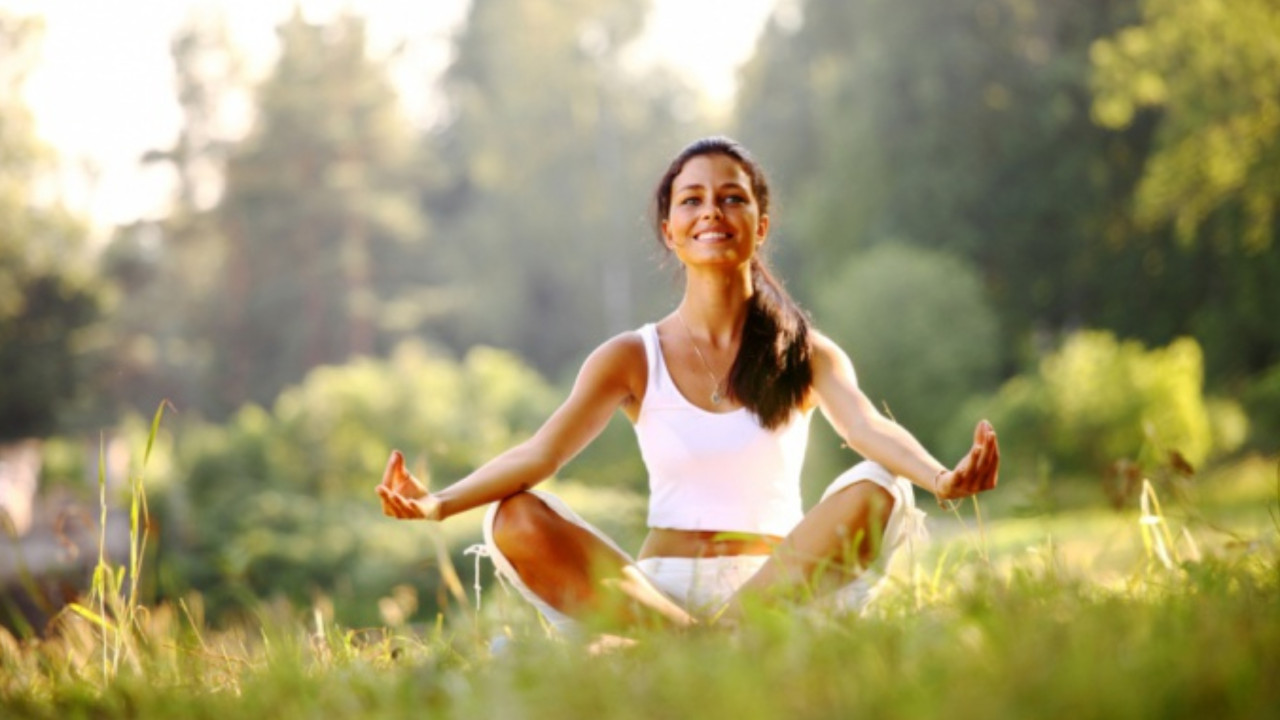Yoga: The Ultimate Guide to Types and Benefits
Yoga, an ancient practice that originated in India, has become a global phenomenon, transforming lives with its holistic approach to health and wellness. Whether you’re a seasoned yogi or a curious beginner, understanding the various types of yoga and their benefits can help you choose the practice that best suits your needs. 
This ultimate guide explores the different styles of yoga, their unique benefits, and how incorporating yoga into your daily routine can lead to a balanced and healthier life.
What is Yoga?
Yoga is an ancient Indian practice that combines physical, mental, and spiritual disciplines. The word “yoga” comes from Sanskrit and means “to yoke” or “to unite.” At its core, yoga aims to bring harmony between the mind, body, and spirit.
While often associated with physical postures (asanas), yoga is much more than that. It encompasses a wide range of practices, including:
1. Asanas:
These physical postures are perhaps the most recognized aspect of yoga in the West. They help develop strength, flexibility, and balance, but they also prepare the body for deeper practices by promoting physical health and mental focus.
2. Pranayama:
This involves various breathing techniques that help control the flow of vital energy (prana) within the body. Pranayama practices can enhance mental clarity, reduce stress, and improve overall well-being by harmonizing the body’s energy.
3. Meditation:
Central to yoga, meditation is about cultivating a state of mental clarity and inner peace. It involves techniques to focus the mind, observe thoughts without attachment, and achieve a state of mindfulness or transcendence.
4. Yoga Nidra:
Often referred to as “yogic sleep,” this practice involves guided relaxation techniques that help the body and mind reach a deep state of rest and rejuvenation. It’s a powerful tool for stress reduction and mental relaxation.
5. Philosophy:
Yoga’s philosophical teachings provide a framework for living a meaningful and ethical life. The ethical guidelines, such as the Yamas and Niyamas, offer advice on how to interact with others and oneself in ways that promote harmony and self-growth.
Together, these elements create a holistic approach to well-being that integrates the body, mind, and spirit.
The Historical Roots of Yoga
The origins of yoga can be traced back to ancient India, with its roots in the Vedic scriptures. The earliest references to yoga practices are found in the Rig Veda, one of the oldest sacred texts. Over centuries, yoga evolved into various schools and paths, each with its unique approach to achieving enlightenment.
Some key historical milestones include:
1. The Upanishads:
Dating back to around 800-200 BCE, the Upanishads are a collection of ancient Indian texts that explore the nature of reality, the self, and the universe.
They form the philosophical bedrock of various Indian spiritual traditions, including yoga. Concepts such as Brahman (the ultimate reality) and Atman (the individual soul) are discussed, setting the stage for later yogic thought and practice.
2. Patanjali’s Yoga Sutras:
Written around the 2nd century BCE, Patanjali’s Yoga Sutras are a foundational text in the study of yoga. Patanjali synthesized and systematized various yogic practices into a coherent framework.
The text outlines the eight limbs (Ashtanga) of yoga, including ethical guidelines, physical postures, breath control, and meditation techniques. This codification helped standardize and preserve yoga practices.
3. Hatha Yoga:
Emerging around the 9th to 15th centuries CE, Hatha Yoga represents a practical and physical approach to yoga, focusing on asanas (postures) and pranayama (breathing techniques) to purify and strengthen the body.
It was developed as a preparatory stage for deeper meditation, emphasizing the importance of bodily discipline and energy control.
Key texts such as the Hatha Yoga Pradipika (15th century CE) and the Gheranda Samhita (17th century CE) outline various practices and techniques central to Hatha Yoga.
These milestones collectively illustrate the evolution of yoga from its philosophical roots in ancient texts to the development of practical techniques aimed at achieving physical and spiritual well-being.
The Modern Version of Yoga
In recent decades, yoga has experienced a remarkable resurgence in popularity worldwide. It has transformed from a spiritual practice to a global wellness phenomenon. Several factors contributed to this renaissance:
- Emphasis on physical and mental well-being: As people sought ways to manage stress and improve overall health, yoga offered a holistic approach.
- Accessibility: Yoga studios and classes became widely available, making it easier for people to incorporate yoga into their lives.
- Celebrity endorsement: High-profile individuals embraced yoga, further increasing its visibility and appeal.
- Scientific research: Studies on the benefits of yoga have supported its effectiveness in reducing stress, improving flexibility, and enhancing overall well-being.
As a result, yoga has evolved into a diverse and inclusive practice, catering to people of all ages, fitness levels, and backgrounds.
The Philosophy of Yoga
Yoga is not merely a physical exercise; it is a profound philosophical system that aims to unite the body, mind, and spirit.
The 8 Eight Limbs of Yoga
Patanjali, an ancient Indian philosopher, outlined the eight limbs of yoga in his Yoga Sutras. These steps provide a comprehensive path to self-realization:
- Yama: Ethical restraints, including non-violence (ahimsa), truthfulness (satya), non-stealing (asteya), celibacy (brahmacharya), and non-possessiveness (aparigraha).
- Niyama: Personal observances, including purity (sauca), contentment (santosa), discipline (tapas), self-study (svadhyaya), and surrender to a higher power (Ishvara pranidhana).
- Asana: Physical postures designed to bring flexibility, strength, and balance.
- Pranayama: Breath control techniques to regulate the mind and body.
- Pratyahara: Withdrawal of the senses from external stimuli.
- Dharana: Concentration or focused attention on a single point.
- Dhyana: Meditation or sustained concentration.
- Samadhi: Union with the divine or a state of blissful consciousness.
The Mind-Body Connection
A central tenet of yoga is the interconnectedness of the mind and body. Yoga philosophy recognizes that the state of the mind directly influences the body, and vice versa.
Physical postures (asanas) and breathing exercises (pranayama) not only improve physical health but also calm the mind and enhance mental clarity.
By cultivating awareness of the body’s sensations and breath, yoga practitioners learn to observe their thoughts and emotions without judgment. This self-awareness is crucial for developing emotional intelligence and managing stress.
Types of Yoga
Yoga indeed encompasses a rich variety of styles, each with its own unique focus and benefits. Here’s a deeper look at these popular types of yoga:
Traditional Styles
1. Hatha Yoga:
- Focus: Foundational practice that covers the basic principles of yoga, including physical postures, breathwork, and meditation.
- Benefits: Improves flexibility, strength, and balance while providing a calming effect on the mind. It’s ideal for beginners.
2. Ashtanga Yoga:
- Focus: A rigorous style that follows a specific sequence of poses, performed in a flowing, synchronized manner with breath.
- Benefits: Builds strength, flexibility, and stamina through its demanding practice. It’s well-suited for those looking for a challenging workout.
3. Iyengar Yoga:
- Focus: Emphasizes precise alignment and detailed instruction, often using props like blocks, straps, and blankets to support poses.
- Benefits: Suitable for practitioners of all ages and abilities. Helps improve alignment and prevent injuries.
4. Kundalini Yoga:
- Focus: Aim to awaken the dormant energy at the base of the spine through a combination of postures, breathing techniques, chanting, and meditation.
- Benefits: Enhances spiritual awareness, energy levels, and emotional balance.
Modern Styles
5. Vinyasa Yoga:
- Focus: Integrates breath with movement, creating a continuous, flowing sequence of poses.
- Benefits: Promotes cardiovascular health, flexibility, and strength. The dynamic flow can be both energizing and soothing.
6. Bikram Yoga:
- Focus: Consists of a fixed sequence of 26 postures and two breathing exercises, practiced in a room heated to about 105°F (40°C).
- Benefits: Increases flexibility and detoxification through heat. The consistent sequence allows practitioners to track their progress.
7. Power Yoga:
- Focus: A high-intensity practice that builds strength and endurance, often incorporating Vinyasa flow elements.
- Benefits: Improves overall fitness, strength, and flexibility. It’s a great choice for those seeking a vigorous workout.
8. Yin Yoga:
- Focus: Involves holding poses for longer periods (typically 3-5 minutes) to target deep connective tissues and fascia.
- Benefits: Enhances flexibility, improves joint mobility, and promotes deep relaxation.
9. Restorative Yoga:
- Focus: Uses props to fully support the body in various poses, allowing for deep relaxation and stress relief.
- Benefits: Helps reduce stress, improve mental clarity, and support the body’s natural healing processes.
Specialized Styles
10. Prenatal Yoga:
- Focus: Tailored for pregnant women, focusing on gentle exercises, relaxation techniques, and preparation for childbirth.
- Benefits: Supports physical and emotional well-being during pregnancy, improves flexibility, and helps with labor preparation.
11. Aerial Yoga:
- Focus: Involves performing yoga poses while suspended in a fabric hammock, allowing for unique movements and increased flexibility.
- Benefits: Enhances flexibility and strength, and offers a playful, creative approach to traditional yoga postures.
Each style of yoga brings something different to the table, so finding the right one often depends on individual goals, physical abilities, and personal preferences.
Benefits of Practicing Yoga
Yoga indeed offers a holistic approach to well-being, impacting various aspects of life. Here’s a breakdown of the benefits:
Physical Benefits
1. Increased Flexibility, Strength, and Balance:
- Regular practice enhances joint mobility and muscle tone, leading to greater flexibility, strength, and balance.
2. Improved Posture and Body Alignment:
- Yoga helps correct postural imbalances, reducing back pain and promoting a healthier, more aligned body.
3. Boosted Immunity:
- Consistent practice can strengthen the immune system, improving overall health and resilience to illness.
4. Enhanced Respiratory Function:
- Deep breathing exercises improve lung capacity and respiratory function, leading to better oxygenation of the body.
5. Better Sleep:
- Yoga practices, particularly relaxation and meditation techniques, can help alleviate insomnia and improve overall sleep quality.
6. Weight Management:
While yoga may not be as intense as some forms of exercise, it can aid in weight loss and maintenance by promoting mindfulness and a healthier lifestyle.
7. Chronic Pain Relief:
- Many practitioners find relief from chronic pain conditions such as arthritis, fibromyalgia, and back pain through regular practice.
Mental and Emotional Benefits
8. Reduced Stress and Anxiety:
- Yoga activates the relaxation response, helping to calm the mind and reduce stress and anxiety levels.
9. Improved Focus and Concentration:
- Regular practice enhances mental clarity and focus, contributing to better cognitive function.
10. Increased Self-Esteem and Body Image:
- Yoga promotes self-acceptance and body positivity, helping to build confidence and improve self-image.
11. Enhanced Emotional Regulation:
- Yoga helps in developing emotional resilience and effective coping mechanisms, contributing to better emotional balance.
12. Greater Self-Awareness:
- Through mindfulness and introspection, yoga fosters a deeper understanding of oneself and one’s emotions.
Spiritual Benefits
13. Deepened Sense of Peace and Well-Being:
- Yoga fosters a connection with one’s inner self, leading to a profound sense of peace and overall well-being.
14. Increased Self-Discovery:
- The practice can facilitate a better understanding of one’s values, purpose, and life direction.
15. Cultivation of Compassion and Empathy:
- Yoga encourages a sense of interconnectedness with others, fostering compassion and empathy in daily interactions.
16. Spiritual Growth:
- For many, yoga is a path to spiritual awakening and enlightenment, offering a means to explore and deepen their spiritual journey.
Yoga’s comprehensive benefits make it a valuable practice for enhancing overall quality of life, addressing physical health, mental well-being, and spiritual growth.
How to Choose the Right Type of Yoga for You?
Choosing the perfect yoga style can feel overwhelming with so many options available.
Let’s break down some key factors to help you find your ideal practice.
Assessing Your Goals
- Physical fitness: If you’re looking for a vigorous workout, consider Power Yoga or Ashtanga.
- Stress reduction: Restorative or Yin Yoga are excellent choices for relaxation and stress relief.
- Flexibility and balance: Hatha or Iyengar Yoga can help improve flexibility and body alignment.
- Spiritual growth: Kundalini or Hatha Yoga often incorporates meditation and philosophy.
Considering Your Physical Condition
- Injuries or limitations: Gentle styles like Restorative or Yin Yoga may be suitable.
- Beginner: Start with Hatha or Vinyasa flow classes for a gradual introduction.
- Pregnancy: Prenatal yoga is specifically designed for expectant mothers.
Finding the Right Teacher
Experience and qualifications: Look for certified teachers with relevant experience.
- Teaching style: Consider if you prefer a strict, structured class or a more free-flowing approach.
- Personality: A good connection with your teacher can enhance your yoga experience.
Remember: The best way to find your ideal yoga style is to experiment. Don’t be afraid to try different classes and listen to your body.
Common Myths About Yoga
Myth 1: Yoga Is Only for the Flexible
Reality: This is one of the most common misconceptions. Yoga isn’t about touching your toes or contorting your body into impossible shapes.
It’s about the journey, not the destination. Yoga is for everyone, regardless of flexibility. In fact, regular practice can significantly improve your flexibility over time.
Myth 2: Yoga Is a Religious Practice
Reality: While yoga has its roots in Indian philosophy, it is not a religion. It’s a holistic practice that focuses on physical, mental, and spiritual well-being. Many people practice yoga without any religious affiliation.
Myth 3: You Need to Be Fit to Start Yoga
Reality: Absolutely not! Yoga is accessible to people of all fitness levels. There are gentle and restorative styles designed specifically for beginners and those with physical limitations. Yoga can actually help improve your overall fitness and strength.
Incorporating Yoga into Your Daily Routine
Tips for Beginners
- Start small: Begin with just a few minutes of practice each day and gradually increase the duration.
- Find a suitable style: Explore different yoga styles to find one that resonates with you.
- Listen to your body: Pay attention to your body’s signals and avoid pushing yourself too hard.
- Breathe deeply: Focus on your breath throughout your practice.
- Be patient: Progress takes time. Enjoy the journey and celebrate small victories.
Creating a Home Practice
- Dedicate a space: Create a quiet, clutter-free area for your practice.
- Gather essentials: Invest in a yoga mat, comfortable clothing, and any props you need.
- Follow online resources: Many platforms offer free yoga classes and tutorials.
- Experiment with timing: Find the best time for your practice, whether it’s morning, evening, or midday.
- Create a routine: Establish a consistent practice routine to build discipline.
Combining Yoga with Other Activities
- Yoga and fitness: Incorporate yoga into your workout routine for improved flexibility and balance.
- Yoga and meditation: Combine yoga with meditation for deeper relaxation and mindfulness.
- Yoga and nutrition: Practice mindful eating and incorporate yoga for overall well-being.
- Yoga and sleep: Wind down with a gentle yoga practice before bed for better sleep quality.
FAQs
1. What Is the Best Time of Day to Practice Yoga?
The best time to practice yoga is typically in the early morning, just after waking up. This is when your mind is clear, and your body is fresh, allowing for a focused and calm practice.
However, you can practice yoga at any time that fits your schedule and feels right for you. Some people prefer practicing in the evening to unwind after a busy day.
2. Can Yoga Help with Weight Loss?
Yes, yoga can help with weight loss, especially more vigorous styles like Vinyasa, Ashtanga, and Power yoga. These styles increase heart rate and burn calories while also building muscle.
Additionally, yoga promotes mindfulness, which can help you make healthier food choices and manage stress-related eating.
3. Is Yoga Safe for Everyone?
Yoga is generally safe for most people when practiced correctly. However, if you have any existing health conditions, it’s important to consult with your healthcare provider before starting a new yoga practice.
Some types of yoga may be more suitable than others depending on your physical condition, so it’s crucial to choose a style that matches your needs and abilities.
4. How Often Should I Practice Yoga?
For best results, it’s recommended to practice yoga 3 to 5 times per week. This frequency allows you to build and maintain flexibility, strength, and mental clarity.
However, even practicing once or twice a week can be beneficial. Consistency is key, so find a routine that you can maintain over the long term.
5. Do I Need Special Equipment to Practice Yoga?
You don’t need much to start practicing yoga. A yoga mat is the most essential piece of equipment, providing cushioning and support.
Props like blocks, straps, and bolsters can be helpful, especially in styles like Iyengar and Restorative yoga, but they are not necessary for beginners.
Comfortable clothing that allows for movement is also important. As you advance, you may choose to incorporate more equipment, but starting simple is perfectly fine.
6. Can Yoga Improve Flexibility?
Absolutely! One of the most well-known benefits of yoga is improved flexibility. Regular practice of yoga stretches and lengthens muscles, which helps increase your range of motion.
Over time, you’ll notice a significant improvement in your flexibility, whether you’re a beginner or an experienced practitioner.
7. What Should I Eat Before and After Yoga?
It’s best to practice yoga on an empty stomach, so try to avoid eating a heavy meal at least 2-3 hours before your session.
If you need a snack, opt for something light like a banana or a handful of nuts about 30 minutes before you practice.
After yoga, it’s important to rehydrate and replenish your body with a balanced meal that includes proteins, healthy fats, and carbohydrates.
8. How Long Should a Yoga Session Last?
The length of your yoga session can vary depending on your schedule and goals. A typical yoga session lasts between 60 to 90 minutes, but even a 15-30-minute session can be beneficial, especially if you’re short on time.
The key is to find a duration that fits your lifestyle and allows you to practice consistently.
9. Can I Practice Yoga if I Have Injuries or Chronic Pain?
Yoga can be adapted to accommodate injuries or chronic pain, but it’s essential to approach your practice with caution. Gentle styles like Restorative, Yin, or Iyengar yoga, which emphasize alignment and the use of props, are often recommended for those with physical limitations.
Always consult with your healthcare provider and a qualified yoga instructor to modify poses and ensure you’re practicing safely.
10. Is Meditation Part of Yoga?
Yes, meditation is a fundamental aspect of yoga. The practice of yoga includes not just physical postures (asanas) but also breath control (pranayama) and meditation (dhyana).
Meditation in yoga helps calm the mind, reduce stress, and deepen your connection to your inner self. Many yoga classes incorporate meditation or mindfulness practices at the beginning or end of the session.
Yoga offers a comprehensive approach to enhancing both physical and mental well-being. By exploring various styles and embracing the diverse benefits, you can find a practice that supports your unique needs and promotes a balanced, healthier lifestyle.
Resources:

























